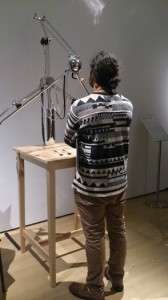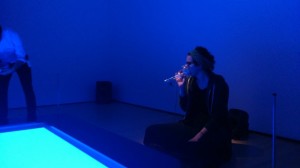By: Philip Figiel
The first part of the trip we looked at the relationship between food, robotics and people interaction with one another. I found the robotic arm feeding you was an interesting idea. Because humans are so use to feeding themselves when they grow up, that having someone else try to feed them seems weird and uncomfortable. Also the fact that the robotic arm was always moving around while trying to feed you, it was hard for the person to pick up visual cues that would notify them that they can lean forward and take the bite. When I tried the robotic arm. I found it hard to trust it to find my mouth, it was always moving around not certain of where to put the spoon. Also I was in a vulnerable state, I had my face right in front of the arm, for all I known it could of poked the spoon into my eye, if it wanted. People and robots always seem to have this disconnection from one another. You can never trust a robot as much as you can trust a person. Because in your mind you know when something goes wrong the person will think fast enough to find a solution to the problem. While a robot can only think as much as it’s code. This sprung the idea for our alcohol spray tasting game that Oliver and I made (taste the rainbow). The notion of not knowing what’s inside the bottles combined with finding a way to describe the taste was an interesting thought to us. Because when it comes to taste we usually tend to describe a taste by mentioning other general tastes like something being sweet or sour. Once you remove that ability to talk about the taste, it gives the player another handy cap. It’s like describing a rainbow to a blind person.
I also found the amount of sugar inside a coke can was pretty crazy. Just with the sugar itself you can fill at least 1/3 of the can. The 3d printer that was making candy was also interesting. I feel like these 3d printers will one day print pretty much anything. I found it funny that the person who was printing the candy hasn’t even tried to taste one of them. I guess it’s because it takes such a long time to create one of them it seems useless if you eat it in 3 seconds for 3 hours of work.
One of the things I found the most interesting was the breathing jellyfish type game. How it work was; you went inside this room with 4 people and each person would sit on the 4 sides of this blue screen that was on the floor. Everyone had a type of breathing mask that was connected to the screen. As the show began there was jellyfish that would appear on the blue screen. And each person was able to control the movement of 4 jellyfish each, with only their breathing. That’s when I really felt like it became a game. I started to set my own goals and try to keep my jellyfish on the other side of the screen, by blowing into the mask really hard. I noticed that everyone else was trying to do the same. It became like a tug of war with breathing. After the jellyfish experience, it really got me thinking of how to incorporate that breathing control scheme into another type of game. Also how we can use other input to make a simple controller more interesting to play and preform. I guess an example of this would be using something like a super Mario game and replace the jumping with a breathing control, so depending on how hard you blow in it the higher you jump.
My experience at Hedonistika was fun and I learned a lot from it. When it comes to development, I think we need to get inspired by other peoples work. Or else your projects would never see newer ideas.

